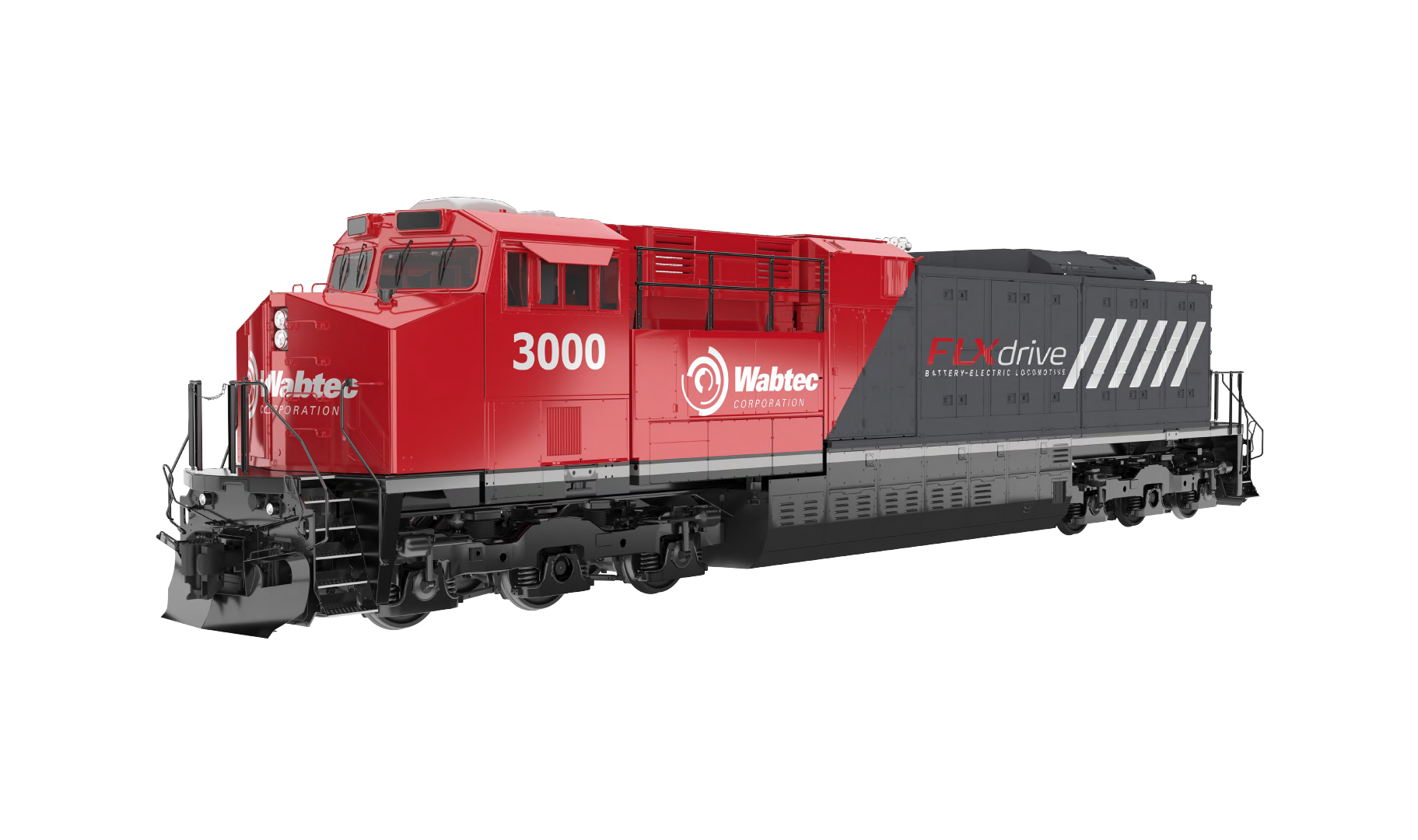The answer, it Wabtec officials seem to say, is by creating an all-electric unit that can be mixed into a consist with existing conventional diesel-electric power.
That’s the idea behind the battery-electric locomotive, branded as FLX Drive, that Wabtec is now building for a test on BNSF Railway routes in California. The locomotive is expected to be delivered in late 2020 and begin testing in early 2021 on a 350-mile stretch of the BNSF between Stockton and Barstow, Calif.
“Really what we said is, ‘Hey, we’re interested not in impacting fuel consumption on a single locomotive, but how do we do it in terms of a consist?’” said Wabtec’s Dennis Peters, executive locomotive platform leader. “Because because that’s how, in North America, locomotives are operated. But we don’t want to touch every locomotive in the consist; we’d like to touch just one locomotive. So the concept for the battery-electric locomotive was born.”
The unit is being built on the core of a Tier-2 locomotive that GE Transportation previously used for liquified natural gas testing. It will use lithium-ion batteries already used in automotive applications — although it will take a whole lot more of them to power a 430,000-pound, 4,400-hp locomotive than it does to move your average Prius. Approximately 20,000 battery cells will be mounted in 20 racks of batteries in the back half of the locomotive.
Peters has been involved in the project for years — before the 2018 merger of Wabtec and GE Transportation — but GE’s interest in hybrid locomotives goes back decades, Peters says. Only now, though, has the combination of battery technology and computer programming made the project truly feasible. GE’s Trip Optimizer software — the autopilot-like program that handles throttle and braking for more efficient train movement — is as crucial to the battery-electric locomotive as the batteries.
“What we focused on is, ‘How do I put a significant amount of energy storage on that, but now smartly operate the train, to be able to maximize fuel or emissions savings, based on what we’re trying to achieve?’ ” Peters says. “By having that knowledge of what’s ahead in the route, we can now smartly charge or discharge energy. And that is a two to three times multiplier of the amount of fuel savings versus just throwing batteries on a locomotive.”
The locomotive’s initial test, planned for about 90 days, will be in California because approximately half of the more than $30 million cost of developing the first battery-electric is being funded by a grant from the San Joaquin Valley Air Pollution Control District. Wabtec estimates that the introduction of the battery-electric locomotive will bring fuel savings of 15 to 20 percent to the entire multiple-locomotive consist.
“We’ll be looking for fuel-consumption improvement … correlation to emission savings, because that’s an important component in California, and then we’ll be doing some yard operations as well,” Peters says.
The locomotive can be charged both by plugging into a charging station — estimated charge time will be 4 to 8 hours — or through the regenerative energy of dynamic braking. It will have a fully equipped cab and will be able to operate independently — the estimate is that it could run on its own at full power for about 45 minutes — but the testing will focus on its use in a multi-locomotive consist, and it is envisioned that, in testing, it will be the second locomotive in that consist.
The unit is not expected to look substantially different than current GE locomotives — “We’re trying to leverage as much of the existing Evolution-series locomotive as possible,” Peters said — but it will not be difficult to spot. Wabtec plans to paint it in the red-and-gray scheme shown in the renderings and videos released this week.
“You’ll be able to know it’s different just by looking at the back half,” Peters said, “but it will still look like a locomotive.”
Beyond the test, Peters said, it remains to be determined how much battery storage will be ideal for such a locomotive, and even exactly a production model’s best appeal to the market will be. In addition to being used to save fuel, it could be used to produce zero-emission miles where the diesel units are taken off lone and the battery locomotive carries all of the power load. Or it could be used to boost power and increase the speed of a train.
“There are all different ways you can go with this,” Peters said. “… That’s part of the flexibility, hence the name FLX Drive.”
Hopes are high for the potential of the unit, and the concept.
“Only time will tell in terms of how big of an advancement [it is],” Peters says. “You think about steam and the movement away from steam. We’ll see how much juice we can get out of this. But I think the timing’s right to do it now. …
“There’s a lot of excitement around looking at this technology and what it can potentially do. And as a new company, this is a big deal for us.”















Sounds like another flop already. Not practical.
Joe K.
You must be one of the lucky few to get a quarter million on your Prius. Have 4 neighbors that owned a Prius. Everyone got rid of them by 85 to 90 k on odometer. Half had battery problems other half had problems with switches, contacts and other electronic parts. Maybe in DRY California it may work. Put it in a high humidity state on gulf coast and see the problems come out.
I know that one data point does not a study make, but we have a 2005 Prius with over 240,000 miles on it. The battery seems to be operating about 90% as efficiently as when new. We expected to have to replace the battery 5 years ago, but it just keeps plugging along.
One thing in this article that shows promise to be even more efficient than our Prius is the ability of the software to anticipate hills and manage the use and storage of power in the battery. I’ve often wished that I could tell my Prius to use more battery power on this particular uphill because there is a long downhill ahead and I don’t want to waste the regenerative braking on a full battery.
How will extremes of weather affect battery operations? Maybe a mix of battery and conventional power plants will be the end result.
It is moving the pollution to a stationary source, but it is far easier to control that pollution when it’s one big stationary source instead of a whole bunch of small mobile sources. A mobile source would need to carry around stuff to control the pollution, which adds weight to it and may not be as effective as it could be because of space and weight constraints. One big stationary source just needs one big pollution control solution, which is far less constrained by space and weight. Also, economies of scale play a big role.
I’m not saying that it’s a good idea or bad idea to create a battery locomotive, but it is an idea and we need more of those to engineer our way forward and solve problems.
Not flat land. Barstow-Stockton includes crossing the Tehachapis.
Whoever owns stock in mining firms extracting cobalt, buy now.
Hardly a decent test ie a flat land application. There will be little chance to charge the unit through DB apps and
as to pollution, the stationary charge is just shifting to another polluting source. But then if you charge in the
daytime CA has an over abundance of solar generated power so that could be a good thing.
Why do I read “The locomotive can be charged both by plugging into a charging station”? That sound very manual labor intensive. I had Lionel trains as a kid so wonder why a fenced in service area, or even a fenced in section of main line could not contain a inner hot rail where the locomotive drops a pick-up shoe to grab juice.
“GE’s interest in hybrid locomotives goes back decades.” This would include the diesel-electric-third rail-battery motors from the 1920’s that NYC used in New York City, especially on the “High Line.”
It saves on air pollution but costs tons of money to mine the components of those 20,000 batteries. However expect to have it hailed as a win win proposition for the environment. Next is just one short in those 20,000 batteries and it converts itself into one big arc welded mass.
This is Wabtec responding to California’s Green New Deal hype and restrictions/incentives, with some SJW language for a bonus.
Simply put, every modern Diesel Electric is a hybrid waiting for enough storage capacity. Even the best battery under current technology would have to be far larger than the locomotive itself to store all the energy being thrown away by the Dynamic Brakes. Then there is the truth that chemical batteries have a problem with rapid charge/discharge cycles. It tears them up fast, which is why you need batteries much larger than the apparent demand.
This could be met better by capacitors as they are built for rapid charge and discharge, and some lab demonstrations have the same capacity as Li batteries. I suspect the reason capacitors have been largely ignored is they are not good at long term storage, where a day or two is about it. But they would be perfect for this as long term storage is not needed and they could be more closely matched to demand as over capacity is not needed. Just remember that if things go horribly wrong it’s like several sticks of dynamite went off. If they became universal several “boiler explosions” would be happening again as routine.
Strange that the people pushing these things don’t seem to understand basic math and physics. (repeat post from other thread)
So basically it’s a high tech slug.
One of the advantages of flat terrain for this kind of test is, you need power to get the train moving. Then you use only as much power as needed to keep the train moving. Then recharge the batteries when you need to slow down.
so this battery powered locomotive is basically an addition to help co exist with diesel locomotives running on low emissions ?
if its used in a consist. why not wire all the other units together so all their braking power goes to the battery unit.
Interesting you said automobile batteries last 5 years – my 6 year battery in my Tesla Model S has lost only 10 miles of range. Newer chemistry batteries are designed to last even longer. The advantage of a battery powered unit is that all the electricity produced when a diesel locomotive dynamically brakes is not wasted as heat but stored to be used again. Similar to driving my Tesla up Mt. Washington (NH) Auto Road – I re gained half the energy used going up with regenerative braking coming back down.
GE was building bi-power and tri-Power units almost a century ago. The problem is that any battery has a short lifespan. Lithium ion batteries are good for five years based upon experience in automobiles. Locomotives, however, ought to last 20-30 years in front line service.
Technically speaking Li batteries are not considered chemical batteries in the sense that lead-acid batteries are, and we already know how to solve the short issue from the problem Boeing had with the 787. As stated in the article, the batteries themselves aren’t the problem, it’s determining how much storage capacity is required, the storage capacity is separate from the batteries. Also, there’s nothing saying you can’t use DB on flat land, it’s just more common o mountainous terrain.
What is the life expectancy of the batteries? What does it cost to replace the batteries?